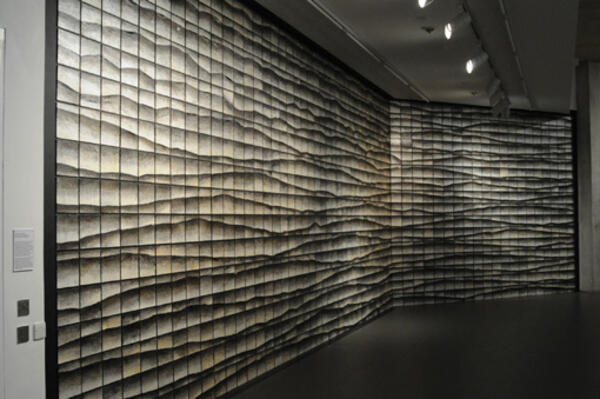Making Art from Fish Skins

“This is made out of sheep testicles,” laughs Elpida Hadzi-Vasileva as she introduces another of her recent works of art.
It’s not that Elpida doesn’t take her work seriously. The Macedonian born artist is laughing at my increasing
bewilderment at the materials she has used. It started off comparably tame - salmon skins used to create hundreds of tiles, a cow’s stomach laid flat for a wall decoration – before Elpida introduced us to some of her more controversial pieces. These include a ball gown made of chicken skin, and duck heads placed on to the bodies of angels at Gloucester Cathedral.
Needless to say, lovers of Romanesque and Gothic architecture were far from amused at the commissioned art, and the duck heads were removed from the 7th Century Cathedral.
This is the world through the eyes of Elpida Hadzi-Vasileva. A full time artist, Elpida operates from a studio in
Plummers Plain. She’s become accustomed to the smell, but it is so overpowering that we needed to step outside on regular occasions for fresh air. In addition to the fish skin tiles, during our visit there’s a tray of hundreds of shrimp heads, an army of quail heads, rabbit jaws, chicken heads, and of course the cow’s stomach on display.
To most people, it might sound ridiculous, and indicative of just how ludicrous modern art can be. But Elpida insists there is meaning behind her work. She said: “I’m interested in the recycling of material, and things that have been rejected but can be turned into an object of beauty. When you talk to people about what you do they think that the materials I work with are quite disgusting but when you look at the objects you can see they can be turned into beautiful things. That is what I am into – the manipulation of something that has been rejected.
“I like having control over something to a particular point, but then stepping away and letting the material takes over and changes naturally. You cannot predict what will happen. With something like cans or metal, you can control what happens. But the things I make will change over two years, in colouration and even in the way they move.”
Currently, Elpida is the artist in residence at Pied à Terre, a Two Michelin Star restaurant in London. For the last eight months she has been gathering up scraps – taking monkfish skins, chicken bones and scallop beards - from the basement to create several pieces within the Charlotte Street eatery. These include a sculpture made of skate bones in the dining room, a squadron of 200 quail carcasses, a lampshade made of scallop, and the skylight has been covered with 80 translucent white bulbs which are in fact dried out sheep testicles.
There has been much media coverage on Elpida’s residence at Pied à Terre, but the artist says she is occasional bemused by the attention. Elpida said: “We’ve had lots of press coverage to the recent exhibition and it’s been interesting. Unless you tell people what the materials are it is very difficult to see, and that is what has made it interesting. People are asking lots of questions, especially about the light box as people can tell that they are some sort of sacks, but they cannot tell that they are sheep’s testicles. But they eat them at the restaurant, so there is nothing different!”
Elpida’s professional training has taken place in the UK - graduating from the GSA, Glasgow in 1996 and the RCA, London in 1998. This has introduced her to other landscapes, encouraging a broad outlook to her responses to specific places and an understanding of the importance of research for the successful development of her work.
There is great variety in Elpida’s work, but they do follow a similar theme of using unusual materials linked to a specific environment. While it is the testicles and the placing of duck heads on angel statues that may create headlines, some of Elpida’s work has been acclaimed within art circles. Reoccuring Undulation, made by Elpida over a nine month period and incorporating 960 salmon skin tiles, may have put the artist off fish (possibly for the rest of her life!) but it made for a striking spectacle by anyone’s standards at the Compulsive, Obsessive, Repetitive exhibition at The Contemporary Art Museum.
The Beauty of Detail was a large-scale veil-like sculpture using fine metal threads, (stainless steel and brass) woven together into a large maze-like installation. The piece was shortlisted for the Spitalfields Sculpture Prize in 2010.
Elpida was artist in Residence in the Faculty of Media, Art & Communications at the University of Gloucestershire, and based at Gloucester Cathedral from 2008 – 2009. During that time she created Gunna, a chicken dress worn in a performance by Mitra Memarzia. Around that time came ‘To Drape’, a flattened fourth stomach of a cow.
It’s obviously not art that most people would like hanging behind the sofa, but there is a market for Elpida’s work and her unique recycling methods continues to inspire new ideas and catch the eye at contemporary exhibitions. However, like most other artists, buyers are not easy to come by.
Elpida said: “There is so much you can do in this line of art, but it’s not easy at the moment with the economic pressures as not many people are spending money on art. But as always if somebody likes something they will buy it.”
For more on Elpida Hadzi-Vasileva’s art and exhibitions visit her website at www.elpihv.co.uk


